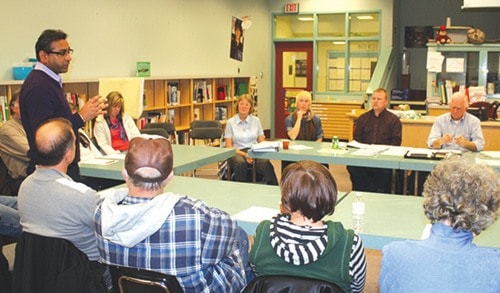Approximately 35 people turned out to the Kaleden Elementary School library on February 5 for a round table discussion of Twin Lakes area issues.
At the heart of the discussion was the proposed Twin Lakes subdivision, with an initial phase of 33 single family units and 40 townhome subdivision to be built on a ridge just north of the golf course.
Future plans also call for a final development of 136 single family homes and 72 townhouses on 100 acres, to be constructed in three phases.
The project has stirred up controversy amongst Twin Lakes residents who feel there is strong evidence that the aquifer is over allocated and cannot handle a development of such magnitude.
Area “D” Director Tom Siddon, who chaired the gathering, suggested that the meeting be used as an “attempt to find a constructive consensus.” He also asked those present to speak to the issues raised with a “tone of open-mindedness,” adding that he himself had been seen as a NIMBY at times.
Also present were several RDOS staff members, Area “G” Director Angelique Wood, and Suki Sekhon, owner of the Twin Lakes golf course.
RDOS staff brought those attending up to date on the history of the subdivision proposal and present state of the application. Development Services Manager Donna Butler noted that the Twin Lakes area - designated as a rural growth area in the Regional Growth Strategy - had been so designated because the zoning for Sekhon’s proposed subdivision had been in place since the mid 1990s. The zoning had also been in place prior to local concerns about water issues.
Sekhon told the gathering that he had been diligent in the fulfillment of all requirements requested of him by the regional district and the Ministry of Transportation and Infrastructure.
A $250,000 water study, paid for by Sekhon and currently being undertaken by Golder and Associates, was in its final stages of completion, with a preliminary report due in May or June.
“The study should tell us what development should take place,” Sekhon said, noting that a community water and sewer system that would come with the development would prove beneficial to existing property owners surrounding his proposed development.
Sekhon also noted that the area had other issues, such as deteriorating roads and the lack of a fire department.
Siddon then asked Sekhon to describe his thought process surrounding the original purchase of the property, with Sekhon responding that he had purchased th property with the concept of developing a golf course community, and had encountered no issues opposing this during the original purchase.
Siddon then observed that there could be possible consequences if the game plan suddenly changed at this point.
Twin Lakes resident Coral Brown, who has acted as spokesperson for many residents in the area, reiterated local concerns about the Twin Lakes aquifer and the impact of development on local species at risk, advising those present that water allotments should not be based on data derived in wet years - like now.
Sekhon replied that the present study represented a “substantial report” and would address all concerns raised by the Ministry of Transportation and Infrastructure.
In response to a question from an audience member who asked him if he had plans for a smaller scale development should the report come back negative, Sekhon replied that he did not.
The water study currently underway elicited further discussion. The study’s potential for impartiality was questioned, as was the need for the study itself, as there were results available from three previous studies on the aquifer.
Sekhon explained that Golder had been hired because they had been involved in the previous study. He noted that the ministry had also been consulted, and were the ones who gave the study its “marching orders”.
Siddon admitted that there was potential for arguments to go “Back and forth” with respect to the validity of the upcoming report. He assured the group that the RDOS would “receive the report with sincerity.”
“The majority of the reports done say that more information is needed,” added RDOS Subdivision Supervisor Stephen Juch. “We’ll have to see what this report says.”
The discussion then moved on to descriptions of the aquifer and the effects of excessive drawdown. It was noted that a depleted aquifer often compacts upon drawdown, compromising future ability to retain water. One resident noted that 10 per cent of Twin Lakes water flowed into the Meyers Flat aquifer, further east and downslope; his message was that aquifer considerations needed to take in areas beyond Twin Lakes.
“Plans should be based on low water years,” he advised the gathering.
In conclusion, Siddon noted that a number of issues and concerns had come to light in the years following the subdivision’ s original zoning, and the RDOS was taking the information into account as policy and bylaws were brought up to date.
“We’re learning things,” he said in conclusion, “we’re not rushing into this.”
